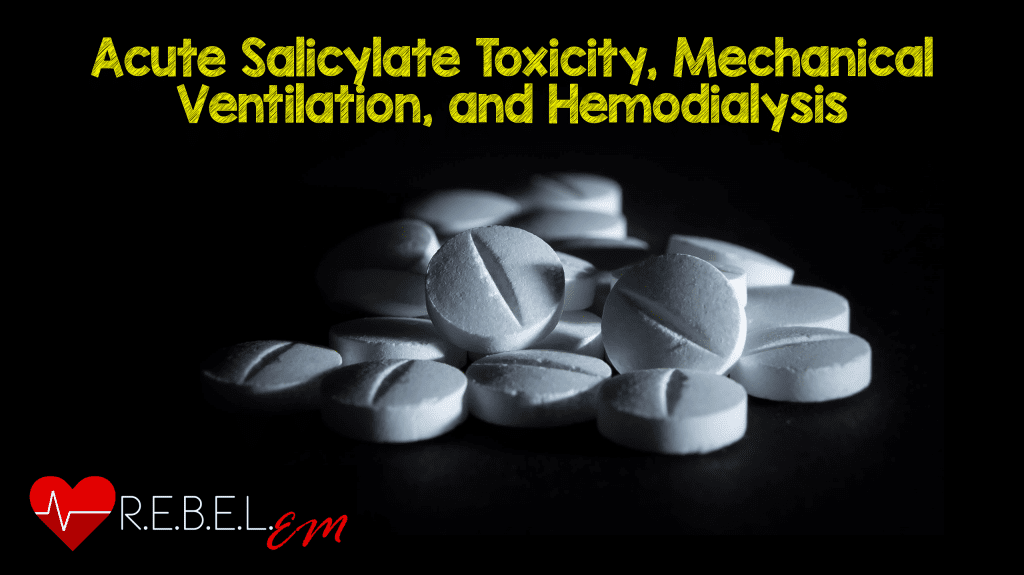
 Background: Salicylates are common substances that can be purchased over the counter. They are readily available, and in the setting of an overdose, can be fatal [1]. Initially, as salicylates are metabolized, they can induce a respiratory alklalosis. This is then followed by an anion gap metabolic acidosis.
Background: Salicylates are common substances that can be purchased over the counter. They are readily available, and in the setting of an overdose, can be fatal [1]. Initially, as salicylates are metabolized, they can induce a respiratory alklalosis. This is then followed by an anion gap metabolic acidosis.
Due to the metabolic derangements induced by salicylates as well as salicylate’s direct stimulation on the respiratory centers of the brain, patients can present with profound tachypnea, fever and even altered mental status. As the severity of toxicity increases, the need for airway protection through intubation and mechanical ventilation becomes more profound.
Intubation has unique implications in patients with acute salicylate toxicity [1]. Patients with tachypnea are able to compensate for the profound metabolic acidosis that can develop from salicylate poisoning. Once intubated, the peri-intubation minute ventilation, typically, cannot be matched by the ventilator, thus taking away the patient’s physiologic mechanism of compensation for the metabolic abnormalities associated with salicylate toxicity leading to further clinical deterioration. Despite this, intubation in many cases of severe salicylate toxicity is necessary.
In addition to ventilation management, other therapeutic options to help manage acute salicylate toxicity include alkalization of the serum to prevent conversion of salicylates to its non-ionized form, which easily crosses the blood brain barrier and can lead to cerebral edema and end organ damage. Hemodialysis is another option in management of salicylate toxicity to help correct acid-base abnormalities and directly remove salicylates from the blood stream [3].
What They Did:
- Retrospective observational study
- Identified cases of salicylate toxicity (level >50 mg/dl) from the Illinois Poison Center associated with the National Poison Data System (NPDS) treatment code of ASPIRIN and INTUBATION
- Of those cases, investigators noted which patients received hemodialysis as part of their management
Outcomes:
- Mortality
Inclusion:
- Patients of all ages recorded as having ingested salicylate and salicylate containing medications resulting in intubation
- Patents were included if salicylate levels >50mg/dl
Exclusion:
- Lack of association with salicylate intoxication
Results:
- 56 Cases Identified
- 41 of those 56 patients survived (73.2%)
- Of the 15 fatal cases, 11 patients (73.3%) did not receive hemodialysis
- 6 patients did not complete HD, all suffering cardiac arrest

Strengths:
- Addresses an important option in managing salicylate poisoning
- Queries a nationally established and reputable data base
- Measures an important, clinically relevant endpoint (i.e. survival)
Limitations:
- Retrospective nature of study (i.e. Can only demonstrate association, not causation)
- Small patient population
- Inclusion of patients that ingested multiple medications
- Unable to distinguish acute vs chronic salicylate toxicity
- Extracted data may have been incomplete
- Inconsistent poison center data acquisition (i.e. May have missed some cases of salicylate toxicity)
Discussion:
- Measured serum salicylate levels can be erratic due to multiple factors. In this study, there were 9 cases of patients with an initial serum salicylate level of <50mg/dL and subsequently increased to a level above toxic thresholds. Two of these patients died and four had HD performed. This fact should emphasize the importance of checking serial levels of salicylate poisoning cases.
- In patients with worsening clinical status, intubation maybe a necessary evil. The issue with intubation is the inability to keep up with the hyperventilation necessary to avoid hypercapnia and worsening acidosis, both of which can lead to cardiac arrest. It is therefore important to consider bicarbonate therapy and hemodialysis in these situations.
- As this paper is limited due to the size of the population and its retrospective nature, consultation with your local poison center is strongly encouraged to help guide management.
Author Conclusion:
“Survival was decreased in these patients if hemodialysis was not performed. Mortality increases with the measured serum salicylate level. Timely hemodialysis for intubated salicylate overdose patients decreases mortality.”
Clinical Take Home Point: In patients requiring intubation from acute salicylate toxicity, hemodialysis should be considered as part of management, as this is associated with decreased mortality.
Guest Post By:

Patrick C Ng
Chief Resident- San Antonio Military Medical Center- PGY 3
Next Year: to Rocky Mountain Poison and Drug Center, Denver CO Toxicology Fellowship
References:
- Chyka PA, et al. Salicylate poisoning: an evidence-based consensus guideline for out-of-hospital management. Clin Toxicol (Phila). 2007;45(2):95-131. PMID: 17364628
- Fernando SM, et al. Hypercapnea and Acidemia despite Hyperventilation following Endotracheal Intubation in a Case of Unknown Severe Salicylate Poisoning. Case Rep Crit Care 2017; 2017: 6835471. PMID: 28465843
- Reingardiene D, Lazauskas R. Acute Salicylate Poisoning. Medicina (Kaunas). 2006; 42(1): 79-83. PMID: 16467617
For More Thoughts on This Topic Checkout:
- Bryan Hayes at The PharmERToxGuy: Hemodialysis and Survival in Intubated Salicylate-Poisoned Patients
Post Peer Reviewed By: Anand Swaminathan (Twitter: @EMSwami) and Salim Rezaie (Twitter: @srrezaie)
The post Acute Salicylate Toxicity, Mechanical Ventilation, and Hemodialysis appeared first on REBEL EM - Emergency Medicine Blog.
